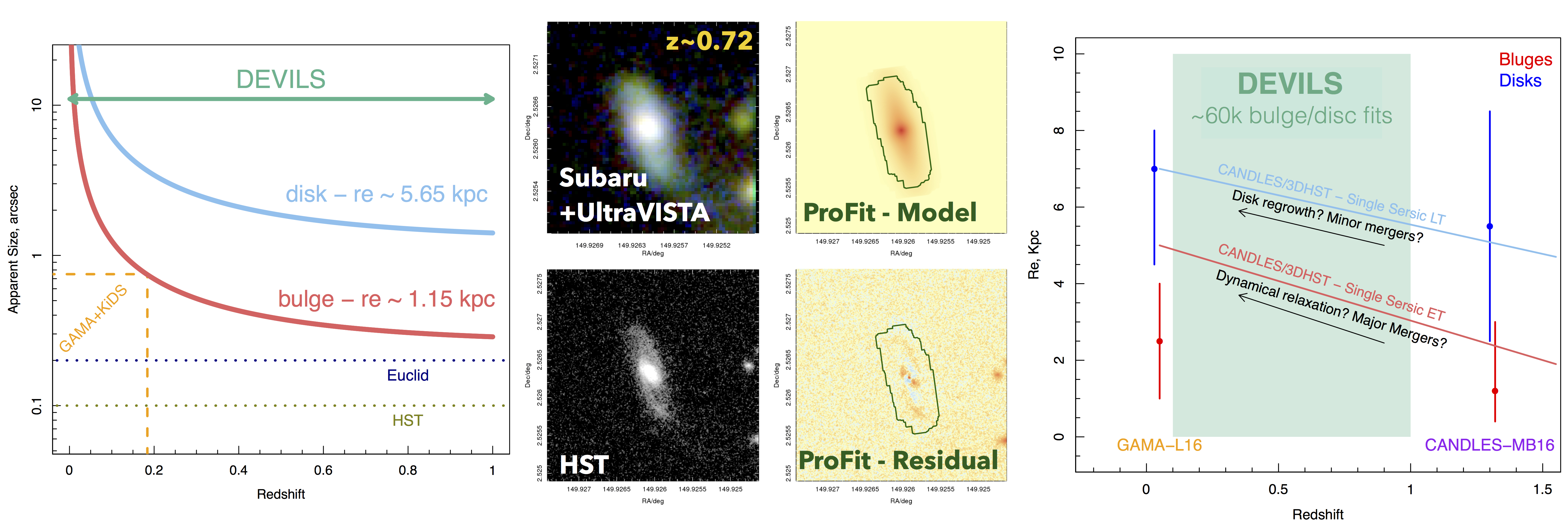Euclid, HST and JWST
Recently, detailed analysis of the structure of galaxies have revealed a ×5 growth in galaxy size at a fixed stellar mass and number density from z > 1 to z < 0.2 (Belli et al., 2016). This exceptional result implies that a dramatic physical change occurs in the structure of galaxies at intermediate redshifts. Potential explanations are diverse, from dynamical relaxation and major mergers, to multiple minor mergers and disc growth. However, a caveat is that, at high-z this result has only been well established for high mass galaxies (> 1011M⊙). As such, it is as yet unclear as to whether this structure evolution is generic or only occurs for specific populations. Previously the analysis of these structural components at z > 0.2 have been confined to small area fields with HST imaging (e.g. CANDELS – 800 arcmin2, Grogin et al. 2011), as deep ground-based imaging (such as KiDS/Subaru) fails to resolve galaxy bulges past z ∼ 0.2. DEVILS will contain > 50,000 redshifts at 0.2 < z < 1.0 over ∼ 6 deg2, which will have complete coverage in either Euclid or HST to resolve individual galaxy components. Using our bespoke structural fitting code, ProFit (Robotham et al., 2017), we will determine the evolution of bulge, disk, bar and spiral arm components over this entire epoch.

Probing the first galaxies is key to our understanding of both the early stages of galaxy formation and evolution, and the contribution of early star-forming galaxies to the UV budget the reionized the Universe. Detecting such systems is the key science driver of NASAs flagship mission the James Webb Space Telescope (JWST). While JWST will be ground breaking in its detection of galaxies in the early Universe (z>10-12), such systems are exceptionally faint (due to their extreme luminosity distance), and as such difficult to detect and/or study in great detail. Gravitational lensing offers a unique probe into the distant Universe, with compact groups at z~0.7 amplifying the light from background sources at z>10 by ~20 times. DEVILS will robustly identify and map hundreds of dark matter halos at intermediate distances, allowing the identification of the best foreground lenses for JWST to probe the early Universe.
JVLA, MeerKAT and SKA
The DEVILS fields are key regions in exploring the radio Universe in the SKA- precursor era. The COSMOS HI Large Extragalactic Survey (CHILES-JVLA, P.I. Van Gorkom) is well underway in COSMOS (~40% complete), and the VIDEO fields will be targeted by MeerKAT in continuum and 21cm (MIGHTEE, co-PI Jarvis) and deep 21cm (LADUMA, co-PI Holwerda). In order to fully exploit these surveys, redshifts will be required for source stacking and environmental metrics with which to explore the influence of environment on HI and provide robust constraints for the treatment of gas in galaxy evolution models. DEVILS will provide these over the CHILES and LADUMA volumes, and a substantial fraction of MIGHTEE. As these volumes will be observed by the SKA precursor projects, it is highly likely that they will be key regions for the SKA.
XMM
DEVILS will probe the large scale structure in 3deg2 of XMM-LSS providing a unique comparison between x-ray clusters/groups and those identified in DEVILS. The group/cluster masses derived from x-ray imaging and weak lensing will provide direct comparisons to those inferred from DEVILS via dynamics and HOD. The combination of DEVILS, deep x-ray (direct detections and group stacking for WHIM), UV- FIR, 21cm observations, and low surface-brightness LSST imaging (ICL and LSBGs) will allow a comprehensive analysis of the evolution of both bound and un-bound baryons from 0 < z < 0.8.
Multi-wavelength data (GALEX, DES, LSST, HSC, VIDEO, VEILS, Spitzer, Herschel…)
An extensive multi-wavelength dataset from UV to FIR is publicly available in the DEVILS fields, and this is set to continue with the next generation of facilities (these regions are LSST deep-drill fields and DEVILS redshifts will be beneficial to LSST – we are formalising our relationship with LSST, and will aim to establish an MoU before we start observations). The combination of these data with a highly complete spectroscopic sample leads to a tantalising prospect for studying many aspects of galaxy evolution science. We will compile all available multi- wavelength data in the DEVILS fields (in collaboration with the Herschel Extragalactic Legacy Program, HELP, team: P.I. Oliver), re-process where appropriate to form a dataset which can be directly comparable to GAMA at low-z, and form a multi-wavelength database as a legacy resource (similar to GAMA/G10-COSMOS/HELP).
OzDES
The DEVILS survey is working in conjunction with OzDES (Dark Energy Survey follow-up spectroscopy for cosmology science). Two of the DEVILS fields (D02 and D03) are also OzDES fields, and hence there will be a significant number of overlapping sources. DEVILS will ingest all previous robust and AAOmega-like resolution spectroscopy in our target fields, and as such has developed an MOU with the OzDES team to share all observed spectra. DEVILS will also be targeting a number of transient OzDES sources during operations in order to increase/extend cadence, and the surveys will be sharing nights at the AAT.

